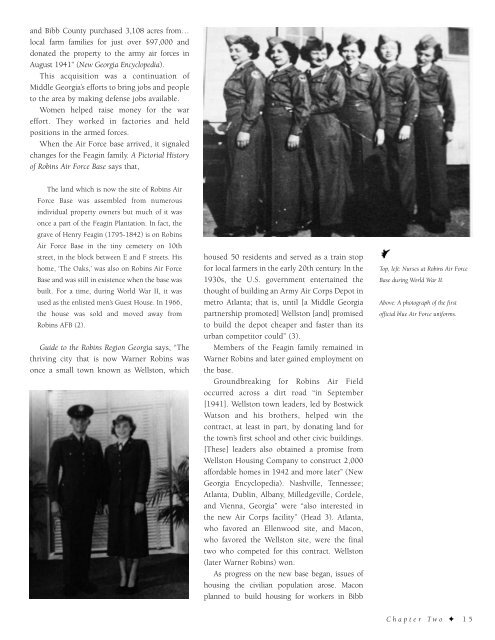Planes, Trains & Heroes: A Story of Warner Robins and the Robins Region
An illustrated history of Warner Robins, Georgia, paired with histories of the companies and organizations that have made the city great.
An illustrated history of Warner Robins, Georgia, paired with histories of the companies and organizations that have made the city great.
- No tags were found...
Create successful ePaper yourself
Turn your PDF publications into a flip-book with our unique Google optimized e-Paper software.
<strong>and</strong> Bibb County purchased 3,108 acres from…<br />
local farm families for just over $97,000 <strong>and</strong><br />
donated <strong>the</strong> property to <strong>the</strong> army air forces in<br />
August 1941” (New Georgia Encyclopedia).<br />
This acquisition was a continuation <strong>of</strong><br />
Middle Georgia’s efforts to bring jobs <strong>and</strong> people<br />
to <strong>the</strong> area by making defense jobs available.<br />
Women helped raise money for <strong>the</strong> war<br />
effort. They worked in factories <strong>and</strong> held<br />
positions in <strong>the</strong> armed forces.<br />
When <strong>the</strong> Air Force base arrived, it signaled<br />
changes for <strong>the</strong> Feagin family. A Pictorial History<br />
<strong>of</strong> <strong>Robins</strong> Air Force Base says that,<br />
The l<strong>and</strong> which is now <strong>the</strong> site <strong>of</strong> <strong>Robins</strong> Air<br />
Force Base was assembled from numerous<br />
individual property owners but much <strong>of</strong> it was<br />
once a part <strong>of</strong> <strong>the</strong> Feagin Plantation. In fact, <strong>the</strong><br />
grave <strong>of</strong> Henry Feagin (1795-1842) is on <strong>Robins</strong><br />
Air Force Base in <strong>the</strong> tiny cemetery on 10th<br />
street, in <strong>the</strong> block between E <strong>and</strong> F streets. His<br />
home, ‘The Oaks,’ was also on <strong>Robins</strong> Air Force<br />
Base <strong>and</strong> was still in existence when <strong>the</strong> base was<br />
built. For a time, during World War II, it was<br />
used as <strong>the</strong> enlisted men’s Guest House. In 1966,<br />
<strong>the</strong> house was sold <strong>and</strong> moved away from<br />
<strong>Robins</strong> AFB (2).<br />
Guide to <strong>the</strong> <strong>Robins</strong> <strong>Region</strong> Georgia says, “The<br />
thriving city that is now <strong>Warner</strong> <strong>Robins</strong> was<br />
once a small town known as Wellston, which<br />
housed 50 residents <strong>and</strong> served as a train stop<br />
for local farmers in <strong>the</strong> early 20th century. In <strong>the</strong><br />
1930s, <strong>the</strong> U.S. government entertained <strong>the</strong><br />
thought <strong>of</strong> building an Army Air Corps Depot in<br />
metro Atlanta; that is, until [a Middle Georgia<br />
partnership promoted] Wellston [<strong>and</strong>] promised<br />
to build <strong>the</strong> depot cheaper <strong>and</strong> faster than its<br />
urban competitor could” (3).<br />
Members <strong>of</strong> <strong>the</strong> Feagin family remained in<br />
<strong>Warner</strong> <strong>Robins</strong> <strong>and</strong> later gained employment on<br />
<strong>the</strong> base.<br />
Groundbreaking for <strong>Robins</strong> Air Field<br />
occurred across a dirt road “in September<br />
[1941]. Wellston town leaders, led by Bostwick<br />
Watson <strong>and</strong> his bro<strong>the</strong>rs, helped win <strong>the</strong><br />
contract, at least in part, by donating l<strong>and</strong> for<br />
<strong>the</strong> town’s first school <strong>and</strong> o<strong>the</strong>r civic buildings.<br />
[These] leaders also obtained a promise from<br />
Wellston Housing Company to construct 2,000<br />
affordable homes in 1942 <strong>and</strong> more later” (New<br />
Georgia Encyclopedia). Nashville, Tennessee;<br />
Atlanta, Dublin, Albany, Milledgeville, Cordele,<br />
<strong>and</strong> Vienna, Georgia” were “also interested in<br />
<strong>the</strong> new Air Corps facility” (Head 3). Atlanta,<br />
who favored an Ellenwood site, <strong>and</strong> Macon,<br />
who favored <strong>the</strong> Wellston site, were <strong>the</strong> final<br />
two who competed for this contract. Wellston<br />
(later <strong>Warner</strong> <strong>Robins</strong>) won.<br />
As progress on <strong>the</strong> new base began, issues <strong>of</strong><br />
housing <strong>the</strong> civilian population arose. Macon<br />
planned to build housing for workers in Bibb<br />
Top, left: Nurses at <strong>Robins</strong> Air Force<br />
Base during World War II.<br />
Above: A photograph <strong>of</strong> <strong>the</strong> first<br />
<strong>of</strong>ficial blue Air Force uniforms.<br />
Chapter Two ✦ 15















